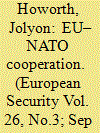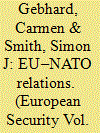| Srl | Item |
| 1 |
ID:
154465


|
|
|
|
|
| Summary/Abstract |
Events in Ukraine have rekindled discussions about NATO’s post-Cold War purpose and the way it relates to the EU. Through EU sanctions and a traditional military response from NATO, the West has manoeuvred itself into a paradoxical situation where every step it takes to reassure its Eastern allies increases rather than diffuses tensions with Russia. On the one hand, it seems that decades of carefully crafted strategic narratives of de-escalation are now in limbo. On the other, it might have indeed been the sustained attempt to create a liberal post-Cold War order that produced an “integration dilemma”, and ultimately drove Russia to the defensive realist logic of a Waltzian “security dilemma”. We argue that NATO’s reaction might have been based on a stylised threat and historical resentments rather than on a carefully calculated risk. Looking beyond the EU and NATO’s recent strategic choices, we argue that the situation can only be resolved by re-engaging Russia in a renewed de-escalatory dialogue that involves both the EU and NATO with a greater emphasis on the nuanced, but important, distinctions between the integration and security dilemmas.
|
|
|
|
|
|
|
|
|
|
|
|
|
|
|
|
| 2 |
ID:
154469


|
|
|
|
|
| Summary/Abstract |
The re-launch of the EU’s security and defence project in the wake of Brexit and the election of Donald Trump has focused the spotlight on the relationship between NATO and the EU. This article reviews the detailed aspects of that relationship as studied in the various contributions to this special issue. It argues that, over and above cooperation on the ground, the key issue to be addressed, which is usually skated over in the “big picture” literature on this question, is: where is all this heading? Is there a move towards a clear EU–NATO division of labour (if so, will it be geographic or functional?); or are the allies seeking a radical new balance of responsibilities and commitment as between the US and the Europeans for the stabilisation of the European neighbourhood? The paper argues that EU “strategic autonomy”, as called for in the Global Strategy document of 2016, can only be achieved through the Europeanisation of NATO itself.
|
|
|
|
|
|
|
|
|
|
|
|
|
|
|
|
| 3 |
ID:
154461


|
|
|
|
|
| Summary/Abstract |
This article provides the framework for the contributions to this special issue. It first puts the theme into context and outlines the main issues that justify further analytical engagement with European Union (EU)–North Atlantic Treaty Organization (NATO) relations to the extent we propose here. We then provide some historical background to frame the discussion, and in doing so also outline the current state of interaction between the EU and NATO. We then briefly contextualise the changing strategic environment shaping the relationship, including recent proposals to implement their declared “strategic partnership”. This introduction then presents an overview of the existing literature to set the stage for a renewed look at the research agenda that has emerged over the last two decades. We close with an outline of the individual contributions to this special issue, which are presented in two sections: one focusing on theoretical and conceptual approaches to the study of EU of EU–NATO relations, and one on the inter-organisational relationship in practice, followed by a concluding synopsis and outlook.
|
|
|
|
|
|
|
|
|
|
|
|
|
|
|
|